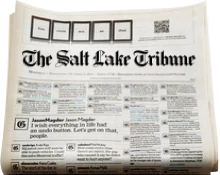This is an archived article that was published on sltrib.com in 2007, and information in the article may be outdated. It is provided only for personal research purposes and may not be reprinted.
NEW YORK - Budweiser and Bud Light once again dominated the Super Bowl ads, but it was the entry of amateurs that caught the eye of a variety of the nation's market experts asked about the annual advertising showdown, which some said didn't pack the punch of previous years.
A group of advertising faculty at Michigan State University voted as their favorite a spot featuring the comic Carlos Mencia teaching a class of immigrants how to ask for Anheuser-Busch Cos.'s Bud Light, saying it cleverly mixed humor with repetitions of the brand name.
Overall, though, Michigan State advertising instructor Dave Regan said he was ''truly not that impressed'' with this year's crop. ''There was nothing that gave me the big 'wow' factor,'' said Regan, who worked in TV advertising for 20 years before taking up teaching.
Of particular interest, he said, was a pair of amateur-produced ads for Doritos, one of which aired early in the game showing a chip-munching driver distracted by a passing woman.
''Giving amateurs a shot at producing this stuff is great,'' Regan said, adding that it was healthy to open up the playing field to ''unjaded minds.''
Other experts also welcomed the YouTube-inspired infusion of new ideas into Super Bowl advertising, but some were skeptical about whether this was the beginning of a new wave of ads generated by users or more of a one-time event.
''As a marketing professor, it was interesting, but as a consumer - I'm not so sure,'' said Ambar Rao, head of the marketing faculty at the Olin School of Business at Washington University in St. Louis.
Other amateurs also found their way into the Super Bowl, but with help. College student Katie Crabb of Wisconsin won a contest held by General Motor's Chevrolet division, and then a team of professionals made her idea for an ad into reality. The NFL also did a professionally made ad based on an idea from a fan.
With the top price for the ads edging as high as $2.6 million for a 30-second spot, once again questions arose over whether advertisers were really getting their money's worth.
Robert Duboff, the head of a marketing consulting firm who also teaches marketing at the MIT Sloan School of Management, noted that it was especially hard for vendors of low-profit-margin products such as candy bars to justify the cost of an ad.
Even if your ad isn't well received by critics, Duboff said there was still no substitute for raising awareness for your brand when 90 million people are watching the broadcast and, with any luck, talking about your brand the next day around the watercooler.
A number of experts, including a panel at the Kellogg School of Management at Northwestern University, found several of the ads confusing, including a spot for Garmin International Inc.'s electronic navigation device that featured a Godzilla-esque battle between a Garmin-themed superhero and a monster made of maps.
''It's a sad commentary that everybody is spending all this money on a message that I'm sure did not get through,'' Duboff said.

